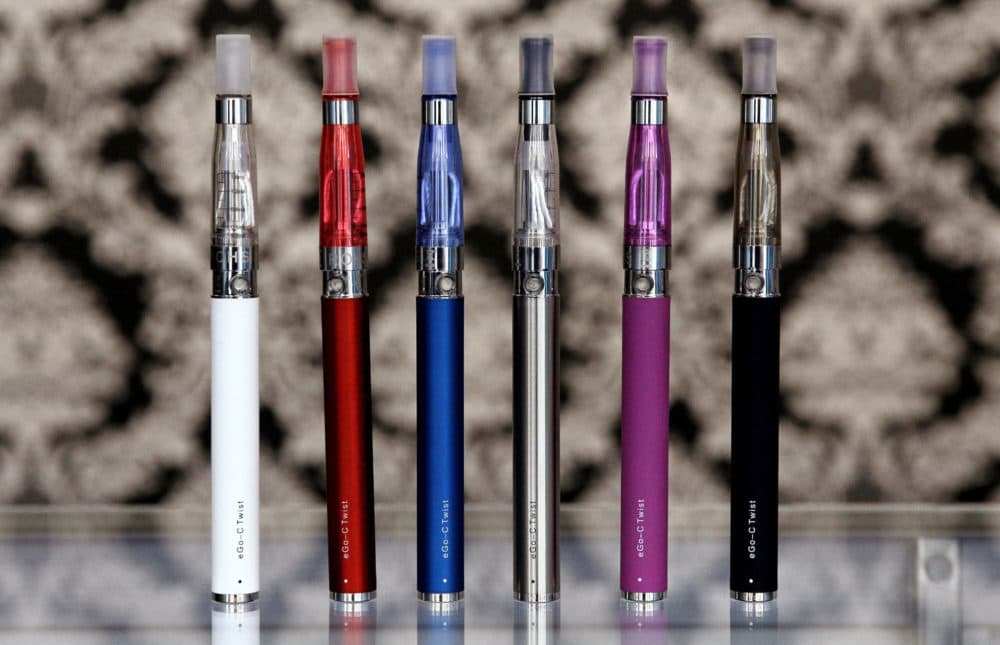Advertisement
Study Finds Signs Of Bacteria And Fungi In Many Vaping Products

Many e-cigarette products show signs of contamination by what could be called e-bugs.
Harvard researchers who tested vaping cartridges and e-liquid products with high nicotine content made by the 10 most popular e-cigarette brands report widespread evidence of bacteria or fungi previously linked to lung problems.
The study, out Wednesday in the journal Environmental Health Perspectives, found signs of bacterial contamination in nearly a quarter of the products tested, and fungal contamination in more than 80%.
David Christiani, a Harvard T.H. Chan School of Public Health professor, says that while the level of exposure is low, the research adds an additional "buyer beware" for users of e-cigarettes. Vaping has exploded among American teens to the point that the U.S. surgeon general has called it an "epidemic."
"The production is not standardized," Christiani says, "and the contents can vary widely. And they can contain a number of agents that are toxic, that can be harmful to health, in addition to nicotine."
He says more research is needed on a wider sampling of vaping products and their effects on human health. The study examined the brands most popular in 2013, and bought them in 2015-16, he says.
Here are a few edited excerpts from our conversation:
How would you sum up your findings?
We looked at e-cigarette products to see if there was any contamination by microbial agents — specifically bacteria or fungi. And so we looked at products that those organisms make, known as endotoxins or glucans. And we found them present for bacterial contamination in about 23% of the products overall. The fungi was present in 81% of the products.
So what's your message to the public?
This just adds one more "buyer beware," that you’re actually inhaling material that has chemical contamination in many cases, and in this case, biological contamination as well — for agents that have been known to cause inflammation and damage to the airways in other settings.
It should be clear that those are usually occupational settings at much higher levels than what we’re measuring here. But still, they are present. And we don’t know what long-term, repeated, cumulative use would mean for someone’s lungs from just e-cigarettes alone.
How would you describe the level of risk for e-cigarette users?
These are low levels of exposure — lower than in tobacco products or traditional cigarettes and lower than in the occupational environment. So this is pretty low-level exposure, but it’s not trivial. In totality, this is added to what we already know are contaminating these products, including a bunch of chemical compounds. So now you add endotoxins and glucans on top of that, and we know from other studies that glucans and endotoxins are not good for your lungs.
Are there studies looking at vaping effects on human health?
They’re coming out now. The literature is starting to really blossom. Long-term studies will take time, just like with other environmental agents, but there is a lot of work going on in e-cigarette exposure in humans, and what even short-term responses — like inflammatory responses — might indicate.
Is the fundamental problem the production practices, or is this contamination inevitable given the materials?
We actually don’t know. We’re not sure at which steps the contamination is taking place. The only thing we can say is that we looked at two different kinds of materials; one was cartridges and one was a free-flowing liquid. And the cartridges had a higher level of contamination than the free-flowing liquid did.
The cartridges usually use cotton wicks. And we know from my previous work in the textile industry that cotton material is more heavily contaminated with compounds like endotoxins. So in that case, it might be right in the wick.
What's your next step?
We’d like to do more human studies of both active and passive exposure to vaping. It might show some of the short-term clinical effects that we’re concerned about.
The other problem is there’s so much variability. We took the top 10-selling brands, but I think there needs to be a larger representative sample of products to confirm these findings. There also need to be studies that figure out what the sources and roots of contamination are. And lastly, the human health effects.
